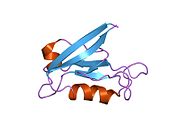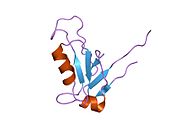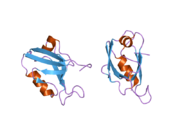DLG1
Discs large homolog 1 (DLG1), also known as synapse-associated protein 97 or SAP97, is a scaffold protein that in humans is encoded by the SAP97 gene.
SAP97 is a mammalian MAGUK-family member protein that is similar to the Drosophila protein Dlg1 (the protein is alternatively referred to as hDlg1, and the human gene is DLG1). SAP97 is expressed throughout the body in epithelial cells. In the brain it is involved in the trafficking of ionotropic receptors from the endoplasmic reticulum to the plasma membrane, and may be involved in the trafficking AMPAR during synaptic plasticity.
Function
[edit]SAP97 is expressed throughout the body in epithelial cells, including the kidney and brain.[5] There is some evidence that SAP97 regulates cell-to-cell adhesion during cell death, and may interact with HPV. In the brain, SAP97's function is involved in the trafficking of transmembrane receptors from the ER to the plasma membrane.[6]
SAP97's function has been investigated by reducing its expression by knockout or increasing its expression heterologously. Mice in which the SAP97 gene has been knocked out die perinatally, have a cleft palate, and deficiencies in renal function.[7][8] Overexpression of SAP97 in mammalian neurons leads to increased synaptic strength.[9]
Clinical significance
[edit]Mutations in DLG1 are associated to Crohn's disease.[10]
Structure
[edit]SAP97's protein structure consists of an alternatively-spliced N-terminal domain, three PDZ domains, an SH3 domain, hook domain, I3 domain, and finally an inactive guanylate kinase (GK) domain. Each of these domains has specific interacting partners that help define SAP97's unique function.
The N-terminal of SAP97 can be alternatively spliced to contain a double-cysteine/palmitoylation site (α-isoform), or an L27 domain (β-isoform. The L27 domain is involved in SAP97 oligomerization with other SAP97 molecules, CASK, and other L27-domain-containing proteins.[11] There is also a myosin VI binding site near N-terminal which may be involved in the internalization of AMPAR.[12][13]
Each of SAP97's PDZ domains have different binding partners, including the AMPAR subunit GluR1[14][15] for the first PDZ domain, and neuroligin for the last. SAP97's I3 domain is unique to SAP97 among the MAGUK family, and is known to regulate the post-synaptic localization of SAP97[9] and to bind the protein 4.1N. The GK domain allows SAP97 to bind to GKAP/SAPAP-family proteins.
References
[edit]- ^ a b c GRCh38: Ensembl release 89: ENSG00000075711 – Ensembl, May 2017
- ^ a b c GRCm38: Ensembl release 89: ENSMUSG00000022770 – Ensembl, May 2017
- ^ "Human PubMed Reference:". National Center for Biotechnology Information, U.S. National Library of Medicine.
- ^ "Mouse PubMed Reference:". National Center for Biotechnology Information, U.S. National Library of Medicine.
- ^ Müller BM, Kistner U, Veh RW, Cases-Langhoff C, Becker B, Gundelfinger ED, Garner CC (Mar 1995). "Molecular characterization and spatial distribution of SAP97, a novel presynaptic protein homologous to SAP90 and the Drosophila discs-large tumor suppressor protein". The Journal of Neuroscience. 15 (3 Pt 2): 2354–66. doi:10.1523/JNEUROSCI.15-03-02354.1995. PMC 6578138. PMID 7891172.
- ^ Sans N, Racca C, Petralia RS, Wang YX, McCallum J, Wenthold RJ (Oct 2001). "Synapse-associated protein 97 selectively associates with a subset of AMPA receptors early in their biosynthetic pathway". The Journal of Neuroscience. 21 (19): 7506–16. doi:10.1523/JNEUROSCI.21-19-07506.2001. PMC 6762903. PMID 11567040.
- ^ Caruana G, Bernstein A (Mar 2001). "Craniofacial dysmorphogenesis including cleft palate in mice with an insertional mutation in the discs large gene". Molecular and Cellular Biology. 21 (5): 1475–83. doi:10.1128/MCB.21.5.1475-1483.2001. PMC 86693. PMID 11238884.
- ^ Mahoney ZX, Sammut B, Xavier RJ, Cunningham J, Go G, Brim KL, Stappenbeck TS, Miner JH, Swat W (Dec 2006). "Discs-large homolog 1 regulates smooth muscle orientation in the mouse ureter". Proceedings of the National Academy of Sciences of the United States of America. 103 (52): 19872–7. Bibcode:2006PNAS..10319872M. doi:10.1073/pnas.0609326103. PMC 1750896. PMID 17172448.
- ^ a b Rumbaugh G, Sia GM, Garner CC, Huganir RL (Jun 2003). "Synapse-associated protein-97 isoform-specific regulation of surface AMPA receptors and synaptic function in cultured neurons". The Journal of Neuroscience. 23 (11): 4567–76. doi:10.1523/JNEUROSCI.23-11-04567.2003. PMC 6740810. PMID 12805297.
- ^ Xu S, Zhou F, Tao J, Song L, Ng SC, Wang X, Chen L, Yi F, Ran Z, Zhou R, Xia B (2014). "Exome sequencing identifies DLG1 as a novel gene for potential susceptibility to Crohn's disease in a Chinese family study". PLOS ONE. 9 (6): e99807. Bibcode:2014PLoSO...999807X. doi:10.1371/journal.pone.0099807. PMC 4061034. PMID 24937328.
- ^ Lee S, Fan S, Makarova O, Straight S, Margolis B (Mar 2002). "A novel and conserved protein-protein interaction domain of mammalian Lin-2/CASK binds and recruits SAP97 to the lateral surface of epithelia". Molecular and Cellular Biology. 22 (6): 1778–91. doi:10.1128/MCB.22.6.1778-1791.2002. PMC 135599. PMID 11865057.
- ^ Wu H, Nash JE, Zamorano P, Garner CC (Aug 2002). "Interaction of SAP97 with minus-end-directed actin motor myosin VI. Implications for AMPA receptor trafficking". The Journal of Biological Chemistry. 277 (34): 30928–34. doi:10.1074/jbc.M203735200. PMID 12050163.
- ^ Osterweil E, Wells DG, Mooseker MS (Jan 2005). "A role for myosin VI in postsynaptic structure and glutamate receptor endocytosis". The Journal of Cell Biology. 168 (2): 329–38. doi:10.1083/jcb.200410091. PMC 2171578. PMID 15657400.
- ^ Leonard AS, Davare MA, Horne MC, Garner CC, Hell JW (Jul 1998). "SAP97 is associated with the alpha-amino-3-hydroxy-5-methylisoxazole-4-propionic acid receptor GluR1 subunit". The Journal of Biological Chemistry. 273 (31): 19518–24. doi:10.1074/jbc.273.31.19518. PMID 9677374.[permanent dead link]
- ^ Cai C, Coleman SK, Niemi K, Keinänen K (Aug 2002). "Selective binding of synapse-associated protein 97 to GluR-A alpha-amino-5-hydroxy-3-methyl-4-isoxazole propionate receptor subunit is determined by a novel sequence motif". The Journal of Biological Chemistry. 277 (35): 31484–90. doi:10.1074/jbc.M204354200. PMID 12070168.
Further reading
[edit]- Humbert P, Russell S, Richardson H (Jun 2003). "Dlg, Scribble and Lgl in cell polarity, cell proliferation and cancer". BioEssays. 25 (6): 542–53. doi:10.1002/bies.10286. PMID 12766944.
- Mukherjee A, Varma SK, Natarajan K (Feb 1972). "Ankle joint instability in poliomyelitis". Indian Journal of Pediatrics. 39 (289): 37–8. doi:10.1007/BF02799404. PMID 5024025. S2CID 46659798.
- Kim E, Niethammer M, Rothschild A, Jan YN, Sheng M (Nov 1995). "Clustering of Shaker-type K+ channels by interaction with a family of membrane-associated guanylate kinases". Nature. 378 (6552): 85–8. Bibcode:1995Natur.378...85K. doi:10.1038/378085a0. PMID 7477295. S2CID 4362906.
- Lue RA, Marfatia SM, Branton D, Chishti AH (Oct 1994). "Cloning and characterization of hdlg: the human homologue of the Drosophila discs large tumor suppressor binds to protein 4.1". Proceedings of the National Academy of Sciences of the United States of America. 91 (21): 9818–22. Bibcode:1994PNAS...91.9818L. doi:10.1073/pnas.91.21.9818. PMC 44908. PMID 7937897.
- Niethammer M, Kim E, Sheng M (Apr 1996). "Interaction between the C terminus of NMDA receptor subunits and multiple members of the PSD-95 family of membrane-associated guanylate kinases". The Journal of Neuroscience. 16 (7): 2157–63. doi:10.1523/JNEUROSCI.16-07-02157.1996. PMC 6578538. PMID 8601796.
- Azim AC, Knoll JH, Marfatia SM, Peel DJ, Bryant PJ, Chishti AH (Dec 1995). "DLG1: chromosome location of the closest human homologue of the Drosophila discs large tumor suppressor gene". Genomics. 30 (3): 613–6. doi:10.1006/geno.1995.1286. PMID 8825652.
- Lue RA, Brandin E, Chan EP, Branton D (Nov 1996). "Two independent domains of hDlg are sufficient for subcellular targeting: the PDZ1-2 conformational unit and an alternatively spliced domain". The Journal of Cell Biology. 135 (4): 1125–37. doi:10.1083/jcb.135.4.1125. PMC 2133382. PMID 8922391.
- Takeuchi M, Hata Y, Hirao K, Toyoda A, Irie M, Takai Y (May 1997). "SAPAPs. A family of PSD-95/SAP90-associated proteins localized at postsynaptic density". The Journal of Biological Chemistry. 272 (18): 11943–51. doi:10.1074/jbc.272.18.11943. PMID 9115257.
- Horio Y, Hibino H, Inanobe A, Yamada M, Ishii M, Tada Y, Satoh E, Hata Y, Takai Y, Kurachi Y (May 1997). "Clustering and enhanced activity of an inwardly rectifying potassium channel, Kir4.1, by an anchoring protein, PSD-95/SAP90". The Journal of Biological Chemistry. 272 (20): 12885–8. doi:10.1074/jbc.272.20.12885. PMID 9148889.
- Lee SS, Weiss RS, Javier RT (Jun 1997). "Binding of human virus oncoproteins to hDlg/SAP97, a mammalian homolog of the Drosophila discs large tumor suppressor protein". Proceedings of the National Academy of Sciences of the United States of America. 94 (13): 6670–5. Bibcode:1997PNAS...94.6670L. doi:10.1073/pnas.94.13.6670. PMC 21216. PMID 9192623.
- Satoh K, Yanai H, Senda T, Kohu K, Nakamura T, Okumura N, Matsumine A, Kobayashi S, Toyoshima K, Akiyama T (Jun 1997). "DAP-1, a novel protein that interacts with the guanylate kinase-like domains of hDLG and PSD-95". Genes to Cells. 2 (6): 415–24. doi:10.1046/j.1365-2443.1997.1310329.x. PMID 9286858. S2CID 8934092.
- Hanada T, Lin L, Chandy KG, Oh SS, Chishti AH (Oct 1997). "Human homologue of the Drosophila discs large tumor suppressor binds to p56lck tyrosine kinase and Shaker type Kv1.3 potassium channel in T lymphocytes". The Journal of Biological Chemistry. 272 (43): 26899–904. doi:10.1074/jbc.272.43.26899. PMID 9341123.
- Reuver SM, Garner CC (Apr 1998). "E-cadherin mediated cell adhesion recruits SAP97 into the cortical cytoskeleton". Journal of Cell Science. 111 (8): 1071–80. doi:10.1242/jcs.111.8.1071. PMID 9512503.
- Leonard AS, Davare MA, Horne MC, Garner CC, Hell JW (Jul 1998). "SAP97 is associated with the alpha-amino-3-hydroxy-5-methylisoxazole-4-propionic acid receptor GluR1 subunit". The Journal of Biological Chemistry. 273 (31): 19518–24. doi:10.1074/jbc.273.31.19518. PMID 9677374.
- Deguchi M, Hata Y, Takeuchi M, Ide N, Hirao K, Yao I, Irie M, Toyoda A, Takai Y (Oct 1998). "BEGAIN (brain-enriched guanylate kinase-associated protein), a novel neuronal PSD-95/SAP90-binding protein". The Journal of Biological Chemistry. 273 (41): 26269–72. doi:10.1074/jbc.273.41.26269. PMID 9756850.
- Brenman JE, Topinka JR, Cooper EC, McGee AW, Rosen J, Milroy T, Ralston HJ, Bredt DS (Nov 1998). "Localization of postsynaptic density-93 to dendritic microtubules and interaction with microtubule-associated protein 1A". The Journal of Neuroscience. 18 (21): 8805–13. doi:10.1523/JNEUROSCI.18-21-08805.1998. PMC 6793550. PMID 9786987.
- Bassand P, Bernard A, Rafiki A, Gayet D, Khrestchatisky M (Jun 1999). "Differential interaction of the tSXV motifs of the NR1 and NR2A NMDA receptor subunits with PSD-95 and SAP97". The European Journal of Neuroscience. 11 (6): 2031–43. doi:10.1046/j.1460-9568.1999.00611.x. PMID 10336672. S2CID 25611356.
- Firestein BL, Firestein BL, Brenman JE, Aoki C, Sanchez-Perez AM, El-Husseini AE, Bredt DS (Nov 1999). "Cypin: a cytosolic regulator of PSD-95 postsynaptic targeting". Neuron. 24 (3): 659–72. doi:10.1016/S0896-6273(00)81120-4. PMID 10595517.
- Hibino H, Inanobe A, Tanemoto M, Fujita A, Doi K, Kubo T, Hata Y, Takai Y, Kurachi Y (Jan 2000). "Anchoring proteins confer G protein sensitivity to an inward-rectifier K(+) channel through the GK domain". The EMBO Journal. 19 (1): 78–83. doi:10.1093/emboj/19.1.78. PMC 1171779. PMID 10619846.
- Adey NB, Huang L, Ormonde PA, Baumgard ML, Pero R, Byreddy DV, Tavtigian SV, Bartel PL (Jan 2000). "Threonine phosphorylation of the MMAC1/PTEN PDZ binding domain both inhibits and stimulates PDZ binding". Cancer Research. 60 (1): 35–7. PMID 10646847.





















